Meta-analyses on Fertilizer Management – Results and Recommendations
This work summarized the critical data gaps found by the 4R Research Fund-supported meta-analysis teams and provided recommendations for field researchers to aid future data synthesis efforts. The publication from this project can be found using the citation: Eagle, A., R. Cook, L. Christianson, D. Harmel, F. Miguez, S. Qian, D. Diaz. 2017. Meta-analysis constrained by data: Recommendations to improve relevance of nutrient management research. Agronomy Journal 109(6):2441-2449. OPEN ACCESS
Funding Partner: The 4Rs Research Fund
Lead PI: Dr. Alison Eagle, Duke University
Collaborators: Dr. Rachel Cook, NCSU; Dr. Daren Harmel, USDA ARS; Dr. Fernando Miguez, Iowa State University (L. Christianson, IDROP Co-PI)
Enhanced Denitrification Technologies for the Delmarva Peninsula
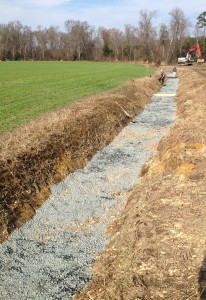 Woodchip denitrifying bioreactors have gained much attention and acceptance over the past decade for treatment of nitrate in subsurface tile drainage. There may be the potential for such enhanced denitrification systems to have wider applicability by, for example, rethinking the carbon source or retrofitting the design to provide treatment of drainage in agricultural ditches. This project developed and evaluated a variety of novel bioreactor designs for the Delmarva Peninsula.
Woodchip denitrifying bioreactors have gained much attention and acceptance over the past decade for treatment of nitrate in subsurface tile drainage. There may be the potential for such enhanced denitrification systems to have wider applicability by, for example, rethinking the carbon source or retrofitting the design to provide treatment of drainage in agricultural ditches. This project developed and evaluated a variety of novel bioreactor designs for the Delmarva Peninsula.
Funding Partner: USDA NRCS Consevation Innovation Grant
Lead PI: Dr. Zach Easton, Department of Biological Systems Engineering, Virginia Tech
Collaborators: Drs. Peter Kleinman and Ray Bryant, USDA ARS; Dr. Arthur Allen, University of Maryland Eastern Shore; L. Christianson, UIUC
Access the publication here: Christianson, L., A. Collick, R. Bryant, T. Rosen, E. Bock, A. Allen, P. Kleinman, E. May, and Z. Easton. 2017. Enhanced denitrification bioreactors hold promise for Mid-Atlantic ditch drainage. & Envir. Letters 2:170032. doi: 10.2134/ael2017.09.0032.
Transformative Soil Health Measures for Resilient 21st Century Illinois Agriculture – Bioreactors and Nematodes
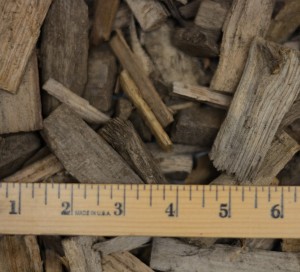 Wood-based denitrifying bioreactors are a proven technology for removing nitrate from several types of waters and wastewaters. A number of research groups are now engaged in evaluating their potential to remove additional contaminants and water/agricultural concerns. With this project, we aim to specifically answer the following questions: (1) Does tile drainage result in export of plant-parasitic nematodes? And (2) Do bioreactors impact nematode communities? This work is an expansion of the UIUC ACES DSynergy Project described on the Soil Health + Water Quality projects page.
Wood-based denitrifying bioreactors are a proven technology for removing nitrate from several types of waters and wastewaters. A number of research groups are now engaged in evaluating their potential to remove additional contaminants and water/agricultural concerns. With this project, we aim to specifically answer the following questions: (1) Does tile drainage result in export of plant-parasitic nematodes? And (2) Do bioreactors impact nematode communities? This work is an expansion of the UIUC ACES DSynergy Project described on the Soil Health + Water Quality projects page.
Funding Partner: The University of Illinois ACES Dudley Smith Initiative DSynergy Program
Co-PI: Dr. Paul Davidson, Biological & Agricultural Engineering, and Dr. Nathan Schroeder, Department of Crop Sciences, University of Illinois (Dr. R. Christianson, Lead PI)
Dissolving uncertainty: A comprehensive evaluation of tile drainage nutrient concentrations
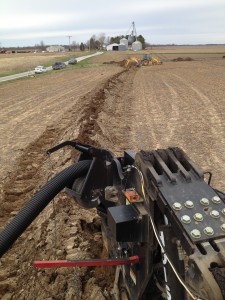 As major P-related water impairments continue to generate headlines and stir regulatory interest, there is an increasing need to better understand factors impacting P transported from areas where agriculture is heavily underpinned by tile drainage. This work builds on the momentum of the previously established “Measured Annual Nutrient loads from AGricultural Environments” (MANAGE) database to develop a new “Drain Concentration” table to answer questions about how and why P is transported in subsurface drainage. More information is available on the project page.
As major P-related water impairments continue to generate headlines and stir regulatory interest, there is an increasing need to better understand factors impacting P transported from areas where agriculture is heavily underpinned by tile drainage. This work builds on the momentum of the previously established “Measured Annual Nutrient loads from AGricultural Environments” (MANAGE) database to develop a new “Drain Concentration” table to answer questions about how and why P is transported in subsurface drainage. More information is available on the project page.
Funding Partner: Illinois Nutrient Research and Education Council
Collaborator: Dr. Daren Harmel, USDA ARS (L. Christianson, Lead PI)
Graduate Student Lead: Allan Hertzberger
10 ways to reduce nitrate loss from drained lands: A comprehensive multimedia outreach package
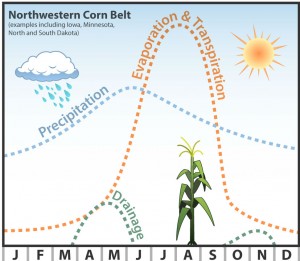 Consistent and thorough information is required to provide clarity about conservation drainage and conservation cropping practices to aid in on-farm decision making by farmers, crop advisors, and drainage professionals, and to assist with informed policy decisions and cost effective watershed planning by local, state, and federal agency staff and watershed and conservation groups. This project will develop new educational products supporting a nearly complete 44-pg booklet entitled Ten Ways to Reduce Nitrogen Loads from Drained Cropland in the Midwest to increase the reach of this material, and to improve understanding of these water quality practices across the multi-state region. Download the booklet here.
Consistent and thorough information is required to provide clarity about conservation drainage and conservation cropping practices to aid in on-farm decision making by farmers, crop advisors, and drainage professionals, and to assist with informed policy decisions and cost effective watershed planning by local, state, and federal agency staff and watershed and conservation groups. This project will develop new educational products supporting a nearly complete 44-pg booklet entitled Ten Ways to Reduce Nitrogen Loads from Drained Cropland in the Midwest to increase the reach of this material, and to improve understanding of these water quality practices across the multi-state region. Download the booklet here.
Funding Partner: The North Central Region Water Network
Collaborators: Dr. Jane Frankenberger, Purdue University; Dr. Chris Hay, Iowa Soybean Association; Dr. Matt Helmers, Iowa State University; Dr. Gary Sands, University of Minnesota
Illinois Nutrient Loss Reduction Strategy Practice Implementation Survey
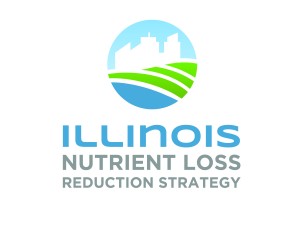 With the Illinois Nutrient Loss Reduction Strategy now in place, the next vital step is to track the state’s progress towards our water quality improvement goals. Many of the recommended practices can only be tracked via survey questions (for example, information about on-farm nitrogen management). Moreover, while information can be gleaned from the NRCS or FSA about practices that involve federal incentive payments (like bioreactors or cover crops), there may be producers who adopt those practices without governmental assistance. The goal of this work is to produce statistically defensible estimates of several in-field and edge-of-field practices conducted by Illinois farmers as those practices relate to the Illinois Nutrient Loss Reduction Strategy. Survey results will be available December 1, 2016 here.
With the Illinois Nutrient Loss Reduction Strategy now in place, the next vital step is to track the state’s progress towards our water quality improvement goals. Many of the recommended practices can only be tracked via survey questions (for example, information about on-farm nitrogen management). Moreover, while information can be gleaned from the NRCS or FSA about practices that involve federal incentive payments (like bioreactors or cover crops), there may be producers who adopt those practices without governmental assistance. The goal of this work is to produce statistically defensible estimates of several in-field and edge-of-field practices conducted by Illinois farmers as those practices relate to the Illinois Nutrient Loss Reduction Strategy. Survey results will be available December 1, 2016 here.
Funding Partner: Illinois Nutrient Research and Education Council and The Illinois Farm Bureau
Lead PI: Dr. George Czapar, Associate Dean and Director of University of Illinois Extension, University of Illinois
Transforming Denitrifying Bioreactor Research and Applications: Unveiling the Inside of the Black Box
 Widespread denitrifying ‘woodchip’ bioreactor implementation is needed to significantly decrease nitrate loads on a regional scale, and the major technical and financial tasks that this entails demand that we transform our approach to their research, design and management to optimize nitrate removal. Bioreactors can no longer be assumed to be ‘black boxes’ under this new, bold way of thinking. We propose a laboratory, field and modeling study to provide novel science-based tools and guidelines needed to improve, optimize and maintain removal efficacy of existing and future bioreactors. For the first time, we will open the bioreactor ‘black box’ using state of the art continuous sensors for water quality and gases to disentangle and quantify the tightly coupled hydraulic and biochemical processes inside.
Widespread denitrifying ‘woodchip’ bioreactor implementation is needed to significantly decrease nitrate loads on a regional scale, and the major technical and financial tasks that this entails demand that we transform our approach to their research, design and management to optimize nitrate removal. Bioreactors can no longer be assumed to be ‘black boxes’ under this new, bold way of thinking. We propose a laboratory, field and modeling study to provide novel science-based tools and guidelines needed to improve, optimize and maintain removal efficacy of existing and future bioreactors. For the first time, we will open the bioreactor ‘black box’ using state of the art continuous sensors for water quality and gases to disentangle and quantify the tightly coupled hydraulic and biochemical processes inside.
Funding Partner: USDA NIFA Foundational Program
Lead PI: Dr. François Birgand, Biological & Agricultural Engineering, North Carolina State University (Dr. L. Christianson, IDROP Co-PI)
Improving denitrifying woodchip bioreactor design and management through denitrification potential testing
This work will improve design and management strategies for woodchip bioreactors by evaluating denitrification potential and nitrous oxide production potential of woodchips, tile drainage water, and soils. Viewing inside the “black box” of these reactors to better understand inherent differences in denitrification potential will allow more informed guidance about woodchip selection, bioreactor start-up management, and design features such as soil covers.
Funding Partner: Illinois Water Resources Center
Lead PI: Dr. L. Christianson; Graduate Student Co-PI: Mary Foltz
Assessing synergies and tradeoffs of recommended BMPs to reduce nutrient losses
Using the newly installed drainage research infrastructure at the University of Illinois Dudley Smith Farm, we seek to answer the question: are current efforts primarily minimizing nitrate losses, but having negative impacts on crop productivity, nutrient utilization, tile drainage P losses, and/or greenhouse gas emissions? This study will provide a critical evaluation of in-field and edge-of-field practices to provide a holistic understanding of best practices for reducing nutrient losses while maintaining crop production goals.
Funding Partner: Illinois Nutrient Research and Education Council
Lead PI: Dr. Cameron Pittelkow, Crop Sciences, University of Illinois (Drs. L. Christianson and R. Bhattarai, Co-PIs)
Coordinated Site Network for Studying the Impacts of 4R Nutrient Management on Crop Production and Nutrient Loss (Nutri-Net Project)
Limited research data linking agronomic and environmental performance of 4R practices across a wide variety of conditions is a critical research gap leading to high uncertainty regarding practice efficacy for both farmers and environmental program and policy decision makers. Along with production and soil health effects, full accounting of the multiple forms and pathways of nitrogen (N) and phosphorus (P) is essential to understand the environmental consequences of current and advanced best nutrient practices.Our objective is to quantify the impact of 4R Nutrient Stewardship on crop yield, soil health, nutrient use efficiencies, nutrient losses with leaching, and gaseous nitrogen losses across a network of coordinated studies in the major corn producing area of North America.